The history of this church is lost in the mists of time, it could well be one of the most ancient of them all, dating back to the 7th century AD.
The current church is the seventh or eighth building to stand on this site. The patron saint is St. Bridget of Ireland. 
Ancient ancient stones. A parliament session was held here in 1210…
Fascinating spire, has some Italian looks about the structure, no? One of the tallest spires in the country, 226 feet in
Did you know, the parents of the first English child born in USA, Virginia Dare in 1587, were married here? 
The church is just off Fleet Street, down a tiny road not longer than 10 meters. 
This is a board outside the church, with fascinating snippets of the history of this church. The crypts were actually discovered as a result of a bomb being dropped on the church in 1940!
A narrow passageway separates the buildings on Fleet Street from the Church. 
An ancient grating with a carved stone lintel on top. It was too worn away for me to make sense of it. 
This doorway originally went into the crypt but for some reason has been bricked up. 
The courtyard. The stones are gleaming from the recent rain…
Looking up at the spire and the damp walls. 

The courtyard is paved with gravestones and bricks.
As a matter of fact, one of the benches rests on a gravestone, you can sit there and do your stuff. Actually, somebody did their stuff and puked all over the gravestone.
I know London doesnt have sufficient space but I feel sad about the gravestones being used and ignored, there was a living breathing human being there, s/he has gone from this earth and this is the only memory left of that person. Sad. 
Walking towards the East side of the church. Lovely pattern of the corner stones of the nave. 
The windows are plain glass, not stained glass. I guess this is because this church building is fairly new? And does not have benefactors? And the publishers and newspaper and journalists and photographers and and and have long since gone from here? Mind you, the previous church buildings did have stained glass and this building itself was raised by private subscriptions from the publishers…
A tree on the side of the courtyard had this lovely little plaque. Be well, Stanley Meagher, you are in my thoughts and in your family’s thoughts. 
Heading back to the door…This church was once rebuilt by Christopher Wren after the Great Fire of 1666. He was an amazing man…
Entering the church, that’s the Royal emblem of the United Kingdom. 
Gilded roses frame the top of the arch as you enter. The contrast between the green stone and the shining bright and gold interior is quite interesting.
I walk into the main church and see this very interesting structure with two huge giant statues on a sort of open doorway. 
Standing at the west end of the church and gazing up. 

The two sides of the church have this rather strange structure, with tall wooden railings. The worshippers wont sit facing the altar, they would sit in parallel rows.
The seats inside the railings had these little plaques stating various people and organisations. For example, the one on the left in the front says, The Society of Women Writers and Journalists. Is this a way to celebrate these organisations? or are these seats reserved for this organisation? Not clear. 
Some basic lamps were aligned on the pews. Looking at the shape, looks like they were previously candle sticks. You can see the wax catcher at the bottom. 
A black and white highly polished marble/black stone floor. 
The altar has a very interesting setup. Bottom you have a nativity scene, then a painting, then a stained glass window, surrounded with this Grecian / roman temple which hides a rather sumptuous painting on the roof. 
Hmmm, bit of a modern representation of Jesus? That too in an eye? 
And the diorama. 

Both sides of the altar are rather bare…
The dome above the altar. It actually looks like a giant smiley face…
But zooming in, its actually a dove..
Looking back at the west end of the church. Amazing structure, with two huge statues at the end. 

On the left is St. Bride. This lady died about 1500 years back. Amazing history of this lovely lady. She is also associated with a cross which you can make following directions here. It will protect you from evil and deprivation. Hmmm, good. On the right is St. Paul. Who is also a fascinating character, one of the most influential Christian leaders in all of Christian History. 
That is the medieval gospel lectern, with the bird shape, framed by this wooden doorway, it survived the bombing by the Luftwaffe and other great tribulations. 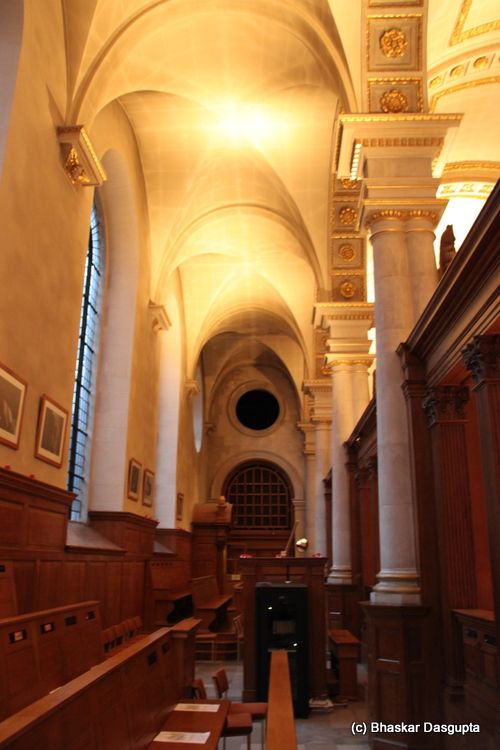

One of the side aisles. Most of the parishioners will sit here. Not sure if the view of the altar is good, that’s why I find this layout bit puzzling.
All this was totally destroyed in the great fire of 1666. I came to know that the church had its own fire engine but did not keep it “scoured, oyled and trimmed” and consequently was completely destroyed when the fire jumped the Fleet River and burnt this down. 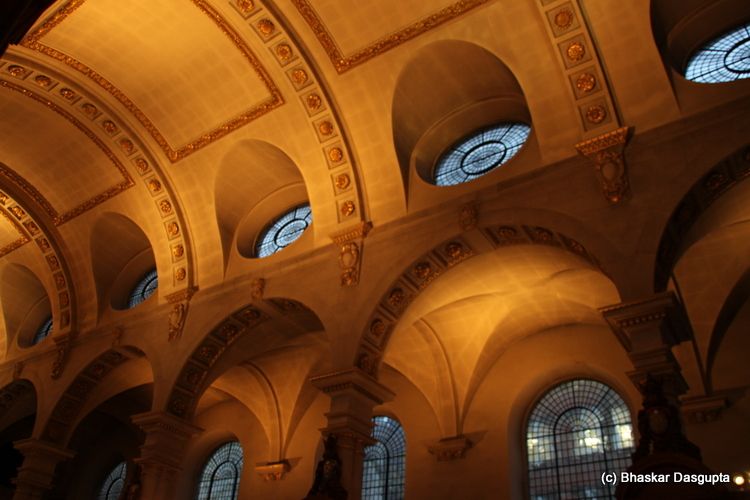

The roof structure is very attractive and interesting, beautiful curves…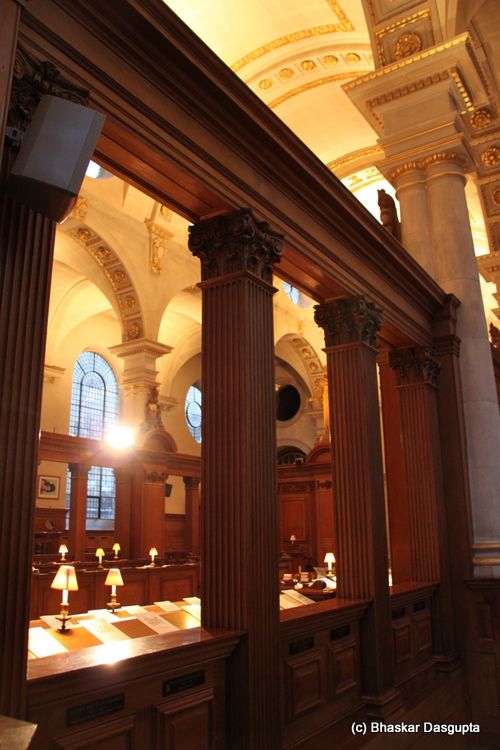
View from one of the side aisles, the view is all blocked by the pillars…
Some of the great and good associated with the church. 
A plaque on the wall celebrating Wynkum de Worde, the first printer in Fleet street who died in 1535..
The fascinating font with two wooden statues in the back..
The little door which leads up to the steeple. 
Looking back at the altar. Unfortunately, the crypt was locked up and I wasnt able to go inside, by all accounts, it would be a fascinating place, here is a bit of a description of the crypt.
I stood for a moment at the church and wanted to listen to the stones. It was strange, the surroundings were very modern but you could hear ancient voices from the crypt. Strange…


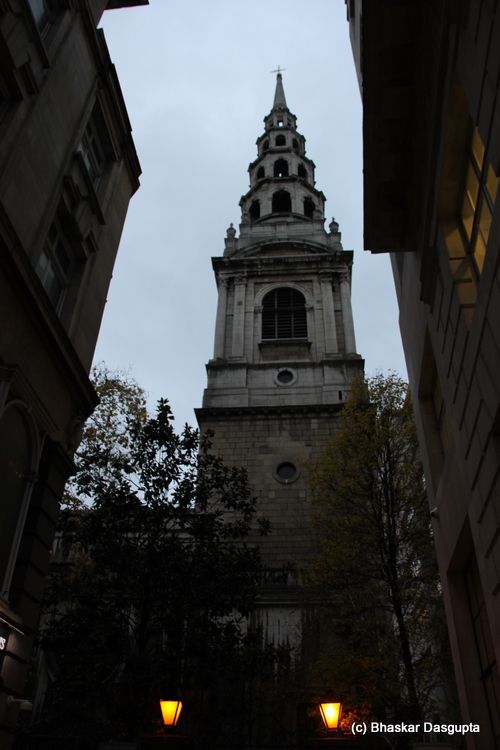
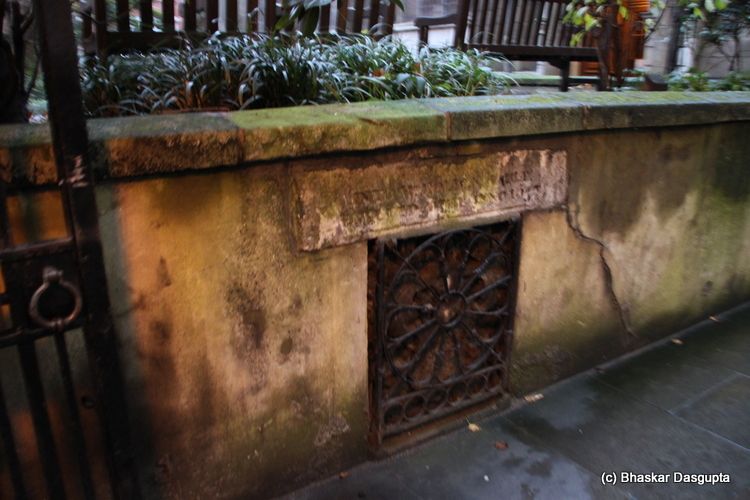






No comments:
Post a Comment